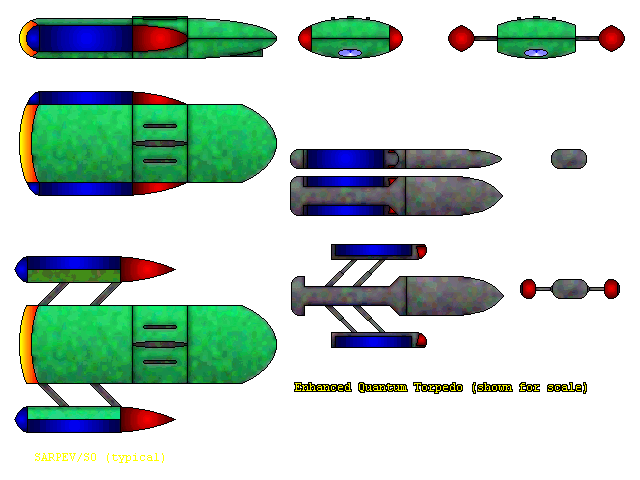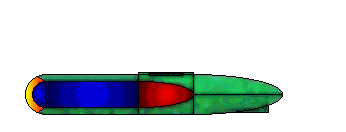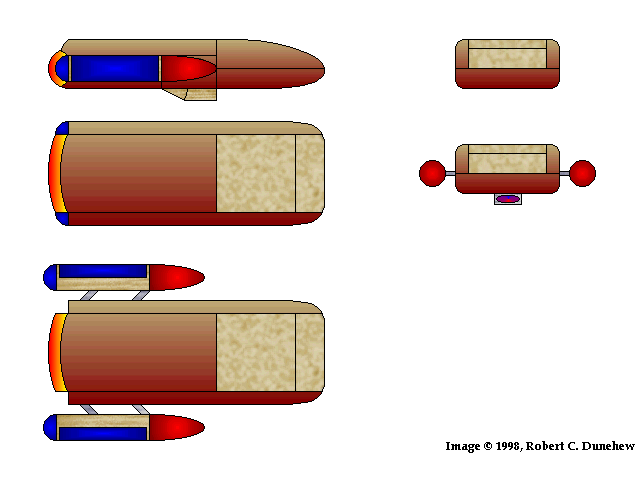

SARPEV Mk II, Special Operations version (SARPEV/SO), Publicly acknowledged as the SARPEV-SU, for "Scientific Utility" version, an adequate ruse as the same shell (without the cloaking device) has since been adapted for large scientific instrument packages.
General Specifications:
Length: 6.4m (6.6m with nacelles extended)
Width: 2.6m (4.5 with nacelles extended)
Height: 1m
Max Warp: 9.99 (burst speed 9.995)
Max Impulse: 0.997 lightspeed
Crew: 1 person, may carry 2 persons for up to 36 hours.
Armaments: Three dorsal hardpoints accept a variety of mission-specific enhancements.
Type: Semi-Autonomous Remotely-Piloted Expendable Vehicle, Mark II,
Special Operations version (SARPEV/SO).
About Ship: During the war with the Dominion, the need for Special
Forces became apparent given the hazardous and mentally intensive nature
of intelligence gathering, demolitions, and search and rescue. A
relatively cheap alternative to other dedicated special operations ships
was required, as losses had become prohibitively high. The introduction
of the SARPEV for other hazardous missions attracted the attention of Special
Operations. The SARPEV was readily available in quantity and quite
easy to modify and maintain, one of the original SARPEV design objectives.
The SARPEV/SO is a modification of the SARPEV. This modification was accomplished by inserting a mission configurable module between a SARPEV engineering module and a special ops-specific habitat module. Utilizing a minimal pilot interface, a special forces operative can launch from a planetary surface, shuttlebay or conventional tri-cobalt device launcher and travel up to 48 hours at almost any speed, though use of highest speeds shortens the service life of the nacelles by 90% or more. The SARPEV/SO is equipped with retractable pads in its belly for planetary landings.
It is equipped with the standard SARPEV holographic cloaking device augmented by a compact Phase-Inverting Multi-band Emission Suppression System (PIMESS), located in the mission configurable module just behind the pilot. Optionally, any of several standard or mission-specific electronic countermeasures and jamming systems can be deployed on the dorsal hardpoints.
Explosive ordnance can be deployed on the smaller dorsal hardpoints to the sides of the main one. The pilot may exit the vehicle to deploy them manually or may use auto-attach clips placed on the device beforehand and pilot the SARPEV to the designated location. In an emergency, payloads attached to the hardpoints may be jettisoned by activating explosive bolts, releasing the hardpoints from the hull.
Another unique feature of the SARPEV/SO is the presence of a backup self-destruct device. Though no one wishes to use it, it is an accepted fact of life by all special forces operators that they engage in activities where their capture would cause grave harm to Starfleet and the Federation. In an emergency, a small quantum filament destruct package within the habitat module is activated by a mechanical switch with quadruply-redundant initiator pathways located next to the pilot’s console. Activation of this switch triggers a similar device in the mission configurable module as well, destroying any sensitive information or technology, to prevent it from falling into the wrong hands.
Primary power is supplied by a quantum flywheel in the engineering section. In recognition of the greater power requirement imposed by the special forces mission profiles, an additional quantum flywheel is mounted in the mission configurable module. These devices are given a full charge by the mothership prior to mission initiation. One advantage of this arrangement is the absence of neutrino emissions characteristically emitted by other power sources.
 Unlike standard SARPEV personnel modules, the SARPEV/SO habitat module
is not equipped with a transparent canopy. Rather, the canopy has the same
holographic skin as the rest of the hull. Any required view of the external
environment, instrumentation, data displays, etc. are visible on the inside
of the canopy as a holographic display. Access to the SARPEV/SO personnel module is facilitated by a hinged canopy.
Unlike standard SARPEV personnel modules, the SARPEV/SO habitat module
is not equipped with a transparent canopy. Rather, the canopy has the same
holographic skin as the rest of the hull. Any required view of the external
environment, instrumentation, data displays, etc. are visible on the inside
of the canopy as a holographic display. Access to the SARPEV/SO personnel module is facilitated by a hinged canopy.

SARPEV, Special Operations version (SARPEV/SO) second version (SO2), Publicly acknowledged as the SARPEV-SU, for "Scientific Utility" version, an adequate ruse as a similar shell has been adapted for large scientific instrument packages.
General Specifications:
Length: 6.9m (7.1m with nacelles extended)
Width: 2.6m (4.5 with nacelles extended)
Height: 1.25m
Max Warp: 9.99 (burst speed 9.995)
Max Impulse: 0.997 lightspeed
Crew: Crew: 1 person. Equipped to carry 2 personnel for up to 36 hours.
Armaments: Attachment points are provided for a mission-specific dorsal pallet.
Semi-autonomous remotely-piloted expendable vehicle, Special Operations version two (SARPEV/SO2).
About Ship: With the introduction of the SARPEV/SO, Special Operations had a tool to perform missions they could never before have considered. Many of these missions were agent extractions or exchanges. Quite frequently, more than one person had to occupy the cockpit of the personnel module, an enclosure that was not always adequate to the task. More than one mission had to be revised to utilize other resources as the agent requiring pick-up or delivery was simply too large to fit into the cockpit.
Rather than trouble Starfleet Engineering, Special Operations assigned several operatives with engineering backgrounds to take advantage of the SARPEV's vaunted adabtability. They revised the 'SO to more closely suit the needs of Special Operations. One of the key SARPEV designers happened to be available from Star Fleet Intelligence, and volunteered to assist with the modifications.
The SARPEV/SO2 is a modification of the SARPEV/SO. The upper shell sections of the SO2 are deepened by ¼ meter (10"), and the rest of the hull is reshaped to maximize internal volume. The habitat module is now the same width as the stardrive section (nacelles retracted) and ½ meter (20") longer than before. All dimensional increases remain within the limits set by the requirement that the device may be deployed from a tri-cobalt device launcher.
The SO2 modification includes such refinements as moving the deflector/sensor array from the habitat module to the the mission configurable module. The new array is retractable and only deploys as required. This removed much of the cockpit clutter, since power and control conduits for deflectors and sensors were no longer routed through the habitat module. The retractable belly skids are no longer installed. The belly has been modified to serve as a landing pad, saving internal space and eliminating parts which could break. Antigrav units are utilized for vertical thrust for takeoffs and landings, doubling as reaction control thrusters while in flight. The access hatch is a two-part unit. The aft section swings up on hinges at its aft edge, while the forward section swings down to form a boarding ramp.
Rather than pods, the SO2 is equipped with a removable mission-specific pallet. This is really nothing more than a conformal pallet into which mission-specific equipment may be loaded. A much larger volume is possible, however, as the pallet extends from just aft of the habitat module to just forward of the impulse thrusters. If the misson profile does not require deployment from a tri-cobalt device launcher, the pallet may be even deeper than ¼ meter.
Like previous models, the SO2 is equipped with standard SARPEV holographic cloaking device augmented by a compact Phase-Inverting Multi-band Emission Suppression System (PIMESS), located in the mission configurable module just behind the pilot. Many standard or special-purpose electronic countermeasures and jamming systems can be deployed within the dorsal pallet. The dorsal pallet may also be configured with demolitions or munitions packages as well.
Special Operations power requirements often tested the limits of the original SARPEV/SO's capacity. For missions requiring additional power, a 1-meter extension is added between the stardrive section and the mission module. This additional section may contain an additional quantum flywheel (QF) or a small fusion generator. This provides Special Ops with flexible options when additional power is required. The fusion generator provides less power than a QF in the short term, but has a total power output exceeding the storage capacity of a single QF. The fusion generator does exact a penalty in the form of additional maintenance, however, as quantum flywheels are very low-maintenance items.
Return to "Ships Starfleet Never Built."
Return to the Starship Catalogue.